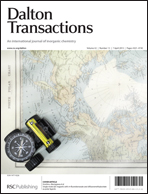The synthesis and antiparasitic activity of aryl- and ferrocenyl-derived thiosemicarbazone ruthenium(ii)–arene complexes†
Abstract
A series of aryl-functionalized and ferrocenyl monothiosemicarbazone compounds (L1–L4) were synthesized in moderate yields via a general Schiff-base condensation reaction. The thiosemicarbazone (TSC) ligands were reacted with the ruthenium dimer [Ru(Ar)(μ-Cl)Cl]2 (Ar = benzene; p-cymene) to yield a series of cationic mononuclear ruthenium(II)–arene thiosemicarbazone complexes of the general type [Ru(Cl)(TSC)(Ar)]Cl (1–8). The thiosemicarbazone ligands act as bidentate chelating ligands that coordinate to the ruthenium(II) ion via the imine nitrogen and the thione sulfur atoms. The thiosemicarbazone ligands, as well as their metal complexes, were characterized by NMR, IR spectroscopy and ESI+-mass spectrometry. The molecular structure of the mononuclear ruthenium(II)–arene thiosemicarbazone complex (6) was determined by single-crystal X-ray diffraction analysis. The ruthenium(II)–arene thiosemicarbazone complexes were further evaluated for their in vitro antiparasitic activities against the Plasmodium falciparum chloroquine-sensitive (NF54) and chloroquine-resistant (Dd2) strains, as well as the G3 strain of Trichomonas vaginalis.


 Please wait while we load your content...
Please wait while we load your content...